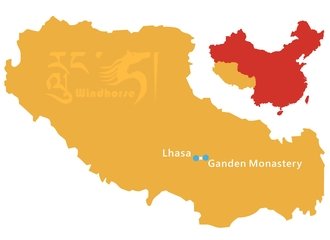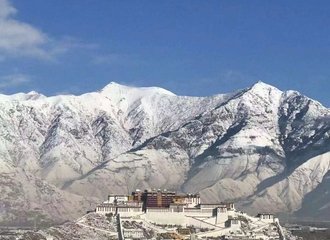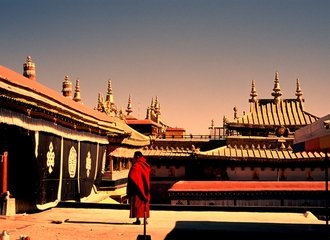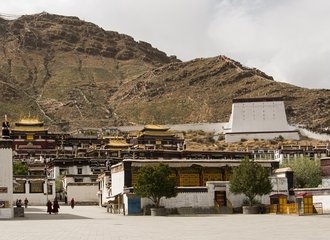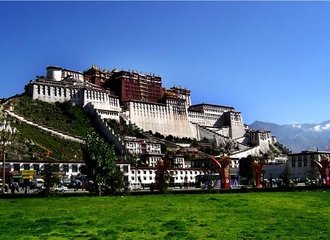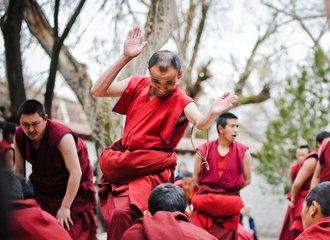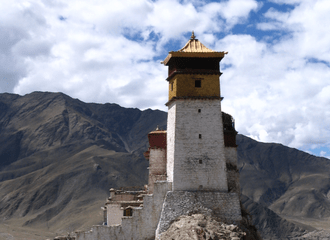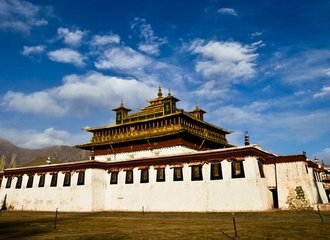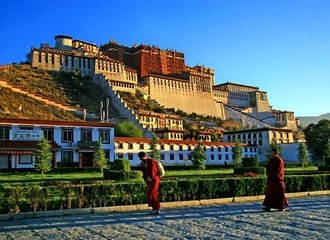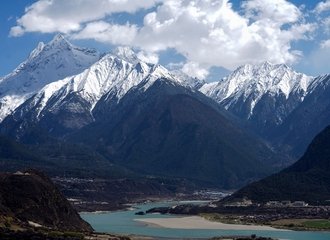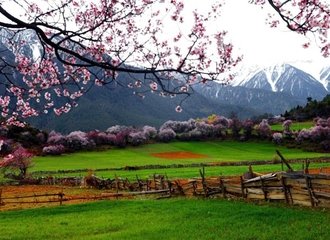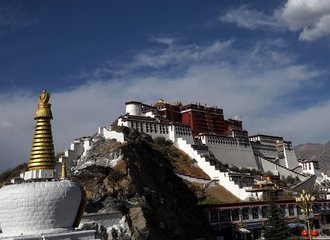Barkhor street in Lhasa - Tibet
Brief Introduction of Barkhor Street
Barkhor Street, a bustling and ancient round street surrounding the Jokhang Temple in the heart of old Lhasa city, is a must-see place for all those who travel to Tibet. Local people are very proud of this street since it serves as the Kora of Jokhang Temple for the pilgrims and the largest marketplace for travelers.
People will be impressed when they first get to Barkhor Street as it presents the original outlook of Lhasa city. Due to the holy Jokhang Temple, the street has been endowed with religious meaning. There are many pilgrims every day holding the prayer wheels to walk clockwise through the street, or even prostrate themselves, facing the entrance of Jokhang Temple. The way they express their piety could make you understand the holiness of Tibetan Buddhism.
For the travelers, Barkhor Street is also a magical place to buy some local souvenirs, Tibetan knives, prayer wheels, long-sleeve "Chuba" (Tibetan people's traditional clothes) and some other religious articles. Numerous shops stand on both sides along the street and thousands of floating stands are on every corner, which makes the street become one of the largest markets in Tibet.
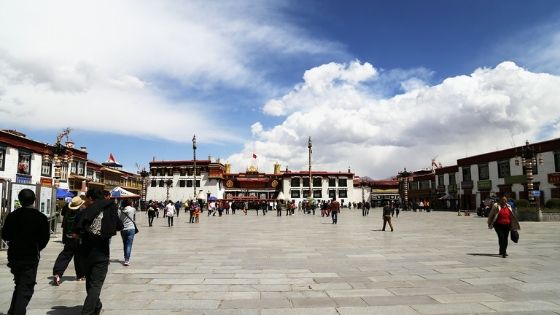
History of Barkhor Street
Barkhor Street is one of the most ancient streets in Lhasa city, which has a history of more than 1300 years. It is closely associated with the development of the Jokhang Temple.
Since Jokhang Temple was built under the supervision of Songtsen Gambo - the first Tibetan King of Tubo Kingdom in the 7th century, the city Lhasa has become the religious center of Tibet. Lots of pilgrims came to prostrate themselves in Jokhang Temple, they needed to pass an alley to get to the temple, and that alley was considered to be the original Barkhor Street. After hundreds of years' development, many 18 family-style architectures were constructed around Jokhang Temple, to allow the pilgrims and businessmen to lodge in when they visited the temple. Living quarters of Buddhists, religious academies and small monasteries, dwellings, and stores also sprung up like mushrooms.
With the improvement of the religious status of the Jokhang Temple in Buddhism, people used to kora around Jokhang Temple to worship the statue of Sakyamuni. Hence, Barkhor Street became one of the three famous Kora streets in Lhasa. Later, a lot of businessmen, Buddhism followers, and tourists from inland China, Mongolia, Kashmir, Nepal, Bhutan, India and some other countries collected here. Barkhor Street developed into a prosperous street that integrates religion, sightseeing, folk custom, local culture, business, and shopping.
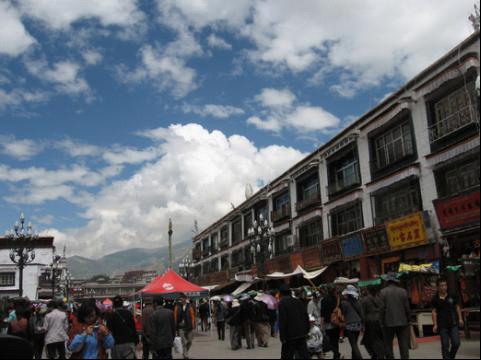
Things to do at Barkhor Street
Do the Barkhor pilgrimage circuit
For the newcomers to Lhasa, it is quite worthwhile to follow the constant stream of Tibetan pilgrims to do the Barkhor pilgrim circuit in a clockwise direction to experience the most representative folk customs and enjoy the distinctive ancient architecture of Tibet. Barkhor Street retains the original features of the ancient city of Lhasa. Streets are paved with hand-polished stones, next to the streets are old-fashioned Tibetan buildings, incense burning inside the stone sangkangs. The Barkhor pilgrim circuit is one of the three important pilgrimage circuits in Lhasa (the other 2 are Nangkhor and Lingkhor) tracing the outskirts of the Jokhang Temple. As soon as the specific time for pilgrimage in the evening arrives, pilgrims from all directions turn to walk strictly along the Barkhor pilgrimage route in a clockwise direction from the commotion of the day.
Wander around the typical featured shops
In addition to its sacred significance, it is the main shopping district for Tibetans, so it should be an ideal place to get close to the local life and buy souvenirs, but do not forget to bargain when you are shopping there. There are more than 120 handicraft shops and 200 sales stalls on both sides of the street selling over 8,000 commodities. Goods from religious items such as bronze Buddha, prayer wheels, butter lamps, prayer flags, etc. to daily necessities including harness, Tibetan shoes, knife and hats, barley wine, sweet tea, butter, dried meat are selling here. Besides, you can easily find typical local Tibetan items like Thangka paintings, Tibetan blankets, Tibetan clothing and gold and silver jewelry, antiques, local specialties in Tibet here. In addition, imported products from India, Nepal, Myanmar, Kashmir and other places can be found here too. Alongside those various shops, there are many small, cheap restaurants specializing in authentic Tibetan food. In addition, here you even can taste different flavors of snacks and cuisines, such as Sichuan cuisine, Cantonese cuisine, Indian, Nepalese, and Western food.

Feel the Romantic Story of Makye Ame
Makye Ame Restaurant, situated in a small typical khaki building painted in yellow at the southeast corner of Barkhor Street, is a must-stop for the visitors traveling to Lhasa due to its fame. Makye Ame means ‘unmarried girl’, coming from the romantic poem of the 6th Dalai Lama called Tsangyang Gyatso, a person not only an outstanding religious spiritual leader but also a talented romantic poet. According to the legend, the small yellow building where Makye Ame Restaurant is situated is said to be the place where Tsangyang Gyatso and Makye Ame met for a date. It is an artistic restaurant with mainly Tibetan, Indian, and Nepalese dishes. Its walls are decorated with paintings, photography, handicrafts and the original books of Kafka, Eliot and others are on its shelf. The roof of Makye Ame is a good point to overlook Barkhor Street.
Visit the cultural relics and historical sites here
Barkhor Street is a well-preserved street with many meaningful historical and cultural relics and traditional houses stored. Currently, there are 29 cultural relics and historical sites as well as 54 preservation ancient building compounds, therefore, it is the best place to see the unique Tibet architecture and learn about Tibet history and culture. Around Barkhor street, here you will have a chance to see 12 typical temples and Lakangs including Buddhist text printing house, Canggu Nunnery, Lhasa Small Mosque, Xiamiyuan Temple, etc. to feel the mixture of multi-culture in Tibet. Another highlight here is an ordinary two-story building named Qujie Podrang in the No. 24 courtyard of North Barkhor Street. It is the famous “Buddha Palace”, honored as the first of the four major palaces and the first house in Barkhor Street. In addition, it also served as a simple palace that Songtsen Gampo built for himself before the construction of Jokhang Temple.


